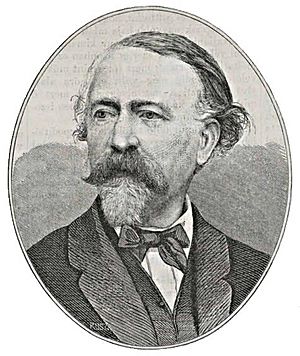Károly Thern facts for kids
Károly (Carl) Thern (born August 13, 1817 – died April 13, 1886) was a talented Hungarian musician. He was a composer, a pianist, a conductor, and an arranger. This means he wrote music, played the piano, led orchestras, and changed music for different instruments. Even though his family was German, he helped create a special Hungarian style of classical music.
Károly Thern was born in 1817. His birthplace was a town called Spišská Nová Ves. This town is now part of Slovakia.
His Musical Career
Károly Thern was very busy in the music world. In the 1840s, he worked as a conductor. He led orchestras at the National Theatre of Pest. Later, from 1868 to 1873, he conducted for the Music Lovers' Association of Pest. He took over this role from another musician, Mihály Mosonyi. Thern also taught music. He was a teacher at the National Conservatory, helping young musicians learn.
His Own Compositions
Károly Thern wrote many different kinds of music. He composed music for plays, which is called incidental music. One example is for a play called Svatopluk in 1839. In this play, he used a special Hungarian instrument called the tárogató. He used it alongside regular orchestra instruments.
He also wrote operas, which are plays set to music. His operas included:
- Gizul (first shown in 1841)
- The Siege of Tihany (Tihany ostroma; first shown in 1845)
- The Would-be Invalid (A képzelt beteg; first shown in 1855)
People said Gizul showed his effort to make his music sound truly Hungarian. Thern also wrote a Symphony in 1871. He created a Trio for two violins and a viola. He wrote a Hungarian March for six hands on one piano. His other works include Landleben, which are 8 short piano pieces. He also wrote a Nocturne for solo piano and songs for plays about Hungarian village life. A Hungarian pianist named Ilona Prunyi has helped people discover Thern's music again.
Music Arrangements
Károly Thern was also skilled at arranging music. This means he took existing pieces and changed them. He often arranged them for piano duet or two pianos. Some of his famous arrangements include:
- Grieg's Piano Concerto in A minor. Grieg started this, and Thern added to it. Thern's version was published in 1876.
- Beethoven's 4th Piano Concerto.
- Liszt's Hungarian Rhapsody No. 15 "Rakoczy March". He used a different name, "Reth. N. Karoly," for this one.
- Schumann's Andante and Variations for two pianos, two cellos, and horn.
- Karl Goldmark's Overture Sakuntala.
- Robert Volkmann's Variations on a Theme of Handel.
His Sons and Franz Liszt
Károly Thern had two sons, Willi and Louis Thern. They were his best piano students. They became a famous team of pianists who played together. Later, they also became teachers.
Thern was a big supporter of the famous composer Franz Liszt. Liszt even used Thern's melody Fóti dal in his own Hungarian Rhapsody No. 1. Liszt also dedicated a piece called Eucharistia to Károly Thern. He dedicated his arrangement of marches by Franz Schubert to Thern's sons, Willi and Louis.
Károly Thern passed away in Vienna in 1886.


